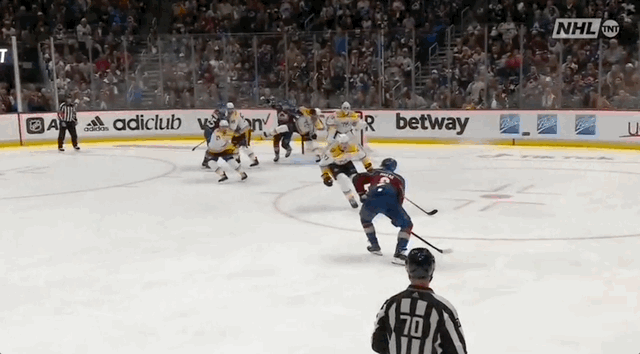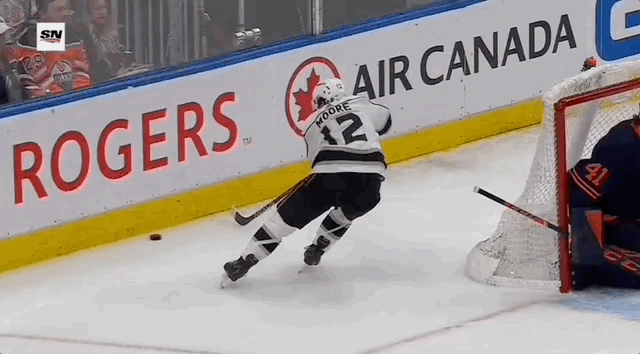The Stanley Cup Playoffs are underway and there’s already a lot to learn from each match up. With each series shifting locations, to the lower seed’s home ice, we’re analyzing takeaways from the first pair of games played so far.
The importance of special teams
The majority of the game is played at 5-on-5, that’s why it’s always emphasized. But the Round 1 series between the Lightning and Maple Leafs have highlighted just how important special teams can be.
In Game 1, it was Toronto’s penalty killing that stood out. That was a strength throughout the regular season, with the fourth-best rate of blocked passes while short-handed and expected goals against, and league-leading quality chance creation. In this game, the Maple Leafs disrupted their opponent’s efforts to enter the zone with control and get set in formation. Deflating the Lightning’s power play that was such a weapon on their Cup run last year is key in this series.
While the Maple Leafs not playing as disciplined worked to their favour in Game 1, the same can’t be said in the next meeting when the Lightning scored three on the advantage. Late in the third, a short-handed goal from Toronto closed the gap, but overall, their penalty killing was not at the heights of the opening game, and their power play fell short. So the special teams battle is proving to be a difference-maker so far.
Managing the Hurricanes’ aggressive style of play isn’t easy
The Hurricanes have been defined by their aggressive style of play over the past few years. In the regular season at 5-on-5, this was one of the best teams at dumping the puck in, battling for possession, taking away the puck from their opponents in the offensive zone, and getting to work generating plays off the cycle. Few teams blocked as many passes or were as active with their sticks to separate their opponents from the puck in the offensive zone to re-gain possession, and they were able to hold the blue line when opponents tried to exit.
That style of play appears to be holding up so far to open the series as they’re preventing Boston from gaining possession and driving out of their own zone. That high-pressure style has provided support for the Hurricanes' second- and third-string goaltenders who have played so far in this series. Now the question is if there will be any sort of shift in momentum as the series moves to Boston with the home team down 2-0.
Is Cale Makar good or something?
Makar’s ’s been outstanding all season with his shifty skating and abilities to walk the blue line, get pucks through traffic, and set up his teammates. That’s shined so far in the playoffs, too. In Game 1, Colorado dominated Nashville on the scoresheet. But in Game 2, in a tight game, his influence was deeper than the final scoresheet showed — and the scoresheet scored a lot with his game-winner in overtime.

In all situations, the defender attempted 25 shots, many of which the Nashville skaters dove in front of to support their goaltender Connor Ingram. Twenty of those shot attempts were attempted at 5-on-5, so it wasn’t a matter of him only influencing play where he had more time and space on the advantage. In all situations, shot attempts were 63-19 in Colorado’s favour while he was deployed. Makar’s 30 loose puck retrievals helped bolster that, as he kept finding ways to get the puck on his stick. At 5-on-5, there was still a major gap of 47-14 in shot attempts. Take out blocks, and the Avalanche still had over double the attempts with Makar on the ice, at 28-13.
Even though the series is shifting back to Nashville, things aren’t looking too bright for the Predators against this loaded Avalanche team — and Makar’s a major reason why.
Igor Shesterkin’s still elite
We already know that Igor Shesterkin was the best goaltender in the regular season, saving a league-leading 40.7 goals above expected. But there were some questions about how he’d handle his first playoff experience.
So far, he’s managing it quite well even when he doesn’t have as much support. In a very long, almost 106-minute performance in all situations to open the playoffs in Game 1, Shesterkin saved 3.4 goals above expected, versus the workload of 7.4 expected goals against on the 132 attempts the Penguins fired his way. His team, on the other hand, generated just 3.67 expected goals for in all situations in that time. In Game 2, Shesterkin actually had some offensive support that even exceeded the workload he faced; still, he put up another quality start with a GSAx of 2.1.
How about those supporting goalies?
Goalie injuries and how backups would manage the workload in the high pressure environment that is the Stanley Cup Playoffs has been a story so far. But we’re not just talking back ups, anymore. Three teams have turned to the third goaler on the depth chart.
In Nashville, it’s Connor Ingram in goal after Juuse Saros was injured and David Rittich struggled. Ingram has had help from the team in front, defensively at least, with a major effort to block as many shots thrown his way. That’s why there’s a gap in attempts and actual shots on goal. That said, against all shot attempts, he’s saved 5.7 goals above expected in 113 minutes of all situation play.
Carolina started with Antti Raanta in net, who played well in Game 1 against Boston. But an injury in Game 2 pulled him from the game, after he earned a 2.2 GSAx in 67.4 minutes of total play in the post-season. In came Pyotr Kochetkov, who gave his team a slightly above average performance.
Move over to Pittsburgh, and there’s Louis Domingue taking over for an injured Casey DeSmith in the second overtime of Game 1. He held steady in net for 16:40 on the way to a Penguins’ win. In Game 2, he was still subjected to 38 shots on goal against, six of which came from the slot.
Now the question is how these unexpected starters will manage moving forward, until there’s a return to the teams’ top two goalies.
The Kings have to play to their defensive strengths if they can’t create offence
In the regular season, the Kings were one of the best defensive teams in the league. Opponents weren’t really able to sustain offensive pressure at 5-on-5 against Los Angeles and generate quality looks off the cycle; the only team to concede a lower rate of slot attempts off the cycle were the Hurricanes. That’s why it’s no surprise the Kings finished with the second best expected goal rate against of 2.2 per 60, trailing only the Bruins.
That defensive play shined in Game 1, when the Kings held the Oilers to just one slot attempt off the rush and four off the cycle at 5-on-5. The Phillip Danault line excelled, and Anze Kopitar held strong in his matchups.

Game 2, however, was a completely different story — and much of it had to do with the little offence the away team managed to create. Asking for Los Angeles to match Edmonton in offensive generation is a stretch given what they create below the surface, and some of their finishing woes. So if the underdogs want to have a shot on home ice, the Kings have to be outstanding defensively.
Data via Sportlogiq







COMMENTS
When submitting content, please abide by our submission guidelines, and avoid posting profanity, personal attacks or harassment. Should you violate our submissions guidelines, we reserve the right to remove your comments and block your account. Sportsnet reserves the right to close a story’s comment section at any time.